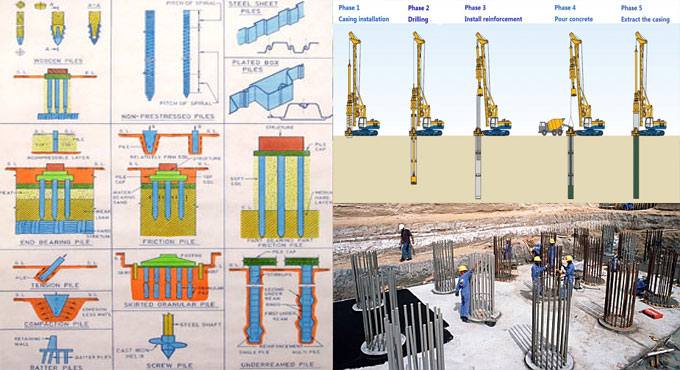
Some vital information on pile foundation
The proportionate depth of the soil is dependent on shallow and deep foundations on which the buildings are constructed. If the depth of a foundation remains under the width of the footing and is below the depth of ten feet, it is known as shallow foundation.
Shallow foundations are developed where soil layer at shallow depth (up to 1.5m) can provide support against the structural loads. The depth of shallow foundations is normally under its width. It signifies that the ratio of depth of foundations to the width of foundation remains same or under 1.
Shallow foundations are suitable when surface soils contain good strength to support the imposed loads. When the depth of a foundation surpasses the width of the building foundation, it is known as deep foundation. Deep foundations are frequently applied to transmit building loads deeper into the ground.
Based on the following factors, the deep foundations are developed.
? Soil adjacent to the surface that contains moderately weak bearing strengths (700 pounds per square foot or less).
? Soils adjacent to the surface that comprise extended clays (shrink/swell soils).
? Surface soils which are exposed erosion or scour and as a result removed easily.
Categorization of deep foundations - Deep foundations are divided into the following three categories:
? Pile foundations
? Well foundations
? Caisson foundations
Pile foundations: A pile foundation includes a series of columns which are erected or implanted into the ground to deliver loads to a lower level of subsoil. A pile stands for a long cylinder that is created with a strong material like concrete. Piles are driven into the ground to provide a strong support to the structures constructed on top of them. Piles transmit the loads from structures to hard strata, rocks, or soil with high bearing strength. Since, pile foundations are placed in the soil, they have good resistance strength against erosion and scour.
How to set up pile foundations: Initially piles are casted at ground level and then hammered or pushed into the ground with the help of a pile driver. A pile driver refers to a machine that retains the pile in vertical direction and hammers it into the ground. Repeated blows are provided by lifting a heavy weight and dropping it on top of the pile. Piles should be hammered into the ground unless the refusal point is attained. It is the point where a pile cannot be pushed into the soil any more.
The pile installation process plays an important role to maintain the structural integrity of pile foundations. The driven-pile method is very useful since it affects the supporting soil around the pile lightly and leads to the greater bearing strength for each pile. Since each pile contains a zone of influence on the soil around it, there should be proper spacing among each pile in order that the loads are allocated consistently.
To get more details on pile, click on the following link schoolofpe.com


